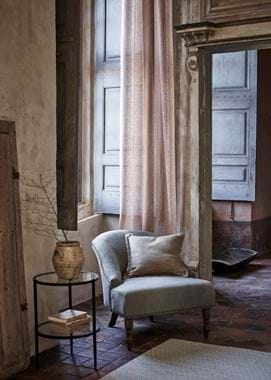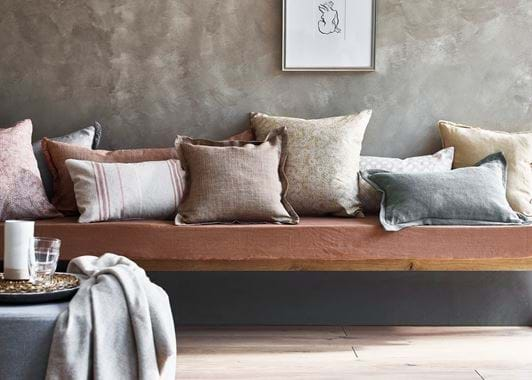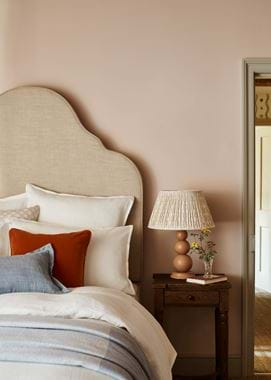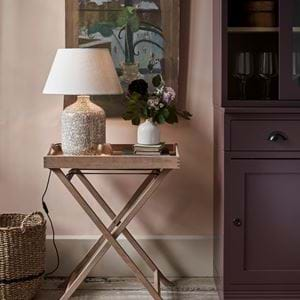A history of linen
A history of linen
Linen has a history longer than almost any other fabric, thanks to one thing: its strength. Many of the world’s oldest surviving fabrics are linens. Fragments of the textile dating back more than 36,000 years have been found in prehistoric caves in Georgia, and the oldest surviving garment, the Tarkhan Dress, is a linen shift unearthed from an Egyptian tomb that’s over 5,000 years old.
These treasures have survived because of linen’s unique character. One of the most resilient organic fibres in existence, it resists mildew, bacteria and rot, and withstands a great deal of wear. These advantages, as well as its appealing earthy texture and a breathable nature that makes it usable year-round, are what makes linen popular in modern homes (and in our collection). What’s more, they’re exactly the same qualities that were prized in the ancient world. Linen was so precious in Egypt that it was traded as a form of currency, and used to make priests’ robes and shrouds for the dead of noble families. In classical Greece, meanwhile, it was considered sturdy enough to use as armour. The linothorax was a kind of breastplate made of linen and animal glue. Mentioned in Homer’s Iliad, it was more forgiving than metal on hot Mediterranean battlefields.
It was the Ancient Egyptians and Mesopotamians who developed the first organised linen industries. Egyptian linen was reserved for the wealthy, probably because the flax plants used to produce it take time to grow and process, and great skill is required to weave the fabric (despite its toughness, flax lacks elasticity and individual threads can snap).
Linen arrived in Britain and Ireland with the Romans. At first, it competed with wool for popularity, but by the time of the Middle Ages it was customary for any garment worn next to the skin to be made from linen, a development that’s left its mark on the modern English language. The words “lingerie” and “lining” are both derived from the word linen. We’ve also inherited linen’s association with purity from our ancestors. Historically, it was hard to dye, so it was usually left its natural oatmeal hue or bleached white. Coupled with biblical references to angels clad in white linen, this cemented the idea of the material as clean and wholesome.
During the Renaissance, pure linen was the height of luxury – especially that from Belgium. Europe had turned out to be the ideal place for cultivating flax - it grows best in a mild, moist climate – and the linen industries in Flanders and Belfast brought huge wealth to these regions. In 1840, it’s estimated that 71 per cent of households in the Flanders town of Tielt were involved in linen production, an industry that thrives locally even now - there’s even a museum dedicated to the fabric’s history in the city of Kortrijk.
Today, linen is enjoying a revival in popularity, but it’s hard to imagine how ubiquitous it once was. As the 19th century and the Industrial Revolution progressed, it was overtaken by cotton, which was far quicker to produce on modern machinery than hand-loomed, slow-grown linen. What ensured linen’s survival was its resilience. In World War Two, it was called upon to make ropes and tarpaulins for the army, with large tracts of land in Ireland set aside for growing flax.
Linen’s beauty, practicality and variety have also kept people coming back to it. It can be robust and rustic, or soft and sheer; rumpled or crisp; and, thanks to modern dyes, it can be any colour of the rainbow. The more you wash it, the softer it gets, and it’s effortless to look after – the only things you should avoid are hanging it outdoors until it’s bone dry (it needs a little moisture to maintain its flexibility) and using harsh detergents, which can bleach the colour.
Just as in the olden days, linen remains an environmentally friendly fabric. Flax farming uses no irrigation or pesticides; the fibres are biodegradable and every part of the plant crop is used, whether for food (flaxseeds and linseed oil) or as a by-product in the making of paper and building materials. The Romans once dubbed linen ‘linum usitassimum’, or ‘most useful linen’. It’s a compliment that’s as true as ever.
Amy Bradford is the former features director of ELLE Decoration. Now a freelance writer and editor, she’s a regular contributor for Neptune and also writes for titles such as The Telegraph and FT How To Spend It. Explore our linen collection of fabrics here, and use them on upholstery, cushions and window treatments.









